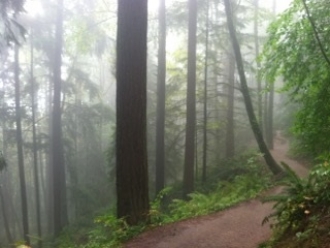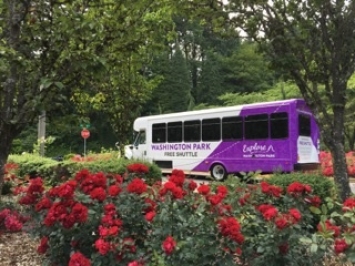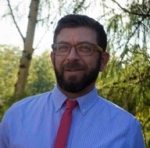Free park-wide shuttle provides critical link to TriMet service
By JP McNeil , June 15 2016
 School is out and summer is heating up, and so are things here in Washington Park as we gear up for the high season.
School is out and summer is heating up, and so are things here in Washington Park as we gear up for the high season.
As most Oregonians know, Washington Park is home to some of Portland’s premiere attractions, including the Oregon Zoo, Japanese Garden and International Rose Test Garden. As such, the park gets very busy during the summer, when visitors from across the region and around the world come to enjoy the exciting attractions and natural beauty of the park.
In the past, this has led to some parking headaches. But here at Explore Washington Park (EWP), we’re working to alleviate some of that pressure. Our job is to help people make decisions about how they get to and around this beautiful park, and to make sure they have what they need for an enjoyable visit.
A Portland gem
Washington Park is one of the oldest parks in Portland. In 1871, the City purchased the original 40 acres of parkland for $32,634 and designated this land "City Park,” despite its relative distance from the central city of the time. The park had few roads and was a wilderness area thick with brush, trees and roaming cougars that discouraged access and daily use of the park.
By 1900, there were roads, trails and landscaped areas with lawns, manicured hedges, flower gardens and a zoo. Cable cars were added in 1890 and operated until the 1930s. Portland's zoo was founded in 1887 near where the reservoirs are presently located. It moved in 1925 to what is now the Japanese Garden, and moved again in 1959 to its present location at the park's southern end.
 The name was officially changed from City Park to Washington Park in 1909 to represent the main street entrance to the park off of SW Washington Street, currently West Burnside St. In 1917, the world-famous International Rose Test Garden opened and helped solidify Portland’s reputation as the Rose City. Today, the 4.5-acre garden is home to over 7,000 rose plants of approximately 550 varieties. The tiered garden overlooks downtown Portland, with views of the Cascades and Mt. Hood.
The name was officially changed from City Park to Washington Park in 1909 to represent the main street entrance to the park off of SW Washington Street, currently West Burnside St. In 1917, the world-famous International Rose Test Garden opened and helped solidify Portland’s reputation as the Rose City. Today, the 4.5-acre garden is home to over 7,000 rose plants of approximately 550 varieties. The tiered garden overlooks downtown Portland, with views of the Cascades and Mt. Hood.
The park expanded to include the southern portion when Multnomah County deeded 160 acres of land that was formally the Multnomah County Poor Farm to the City of Portland. This newly acquired area eventually became home to Hoyt Arboretum, the Oregon Zoo, the World Forestry Center, and the Portland Children’s Museum.
Today, Washington Park covers more than 410 acres on mostly steep, wooded hillsides and is home to memorials, an archery range, tennis courts, soccer field, picnic areas, playgrounds, public art and many acres of wild forest. It also has more than 15 miles of trails, some of which are part of the 40-Mile Loop connecting Washington Park with Pittock Mansion, Forest Park to the north, and Council Crest to the south.
How Explore Washington Park can help
With so many reasons to visit, it’s no wonder the park can be a bit overwhelmed by people trying to get here. That’s where Explore Washington Park comes in. EWP’s goal is to provide transportation options, parking management, way-finding tools and a forum for partners. EWP helps Washington Park visitors enjoy an easy, pleasant experience getting to and around Washington Park.
 There are a number of challenges and opportunities that define our work. Perhaps the greatest opportunity is the MAX light rail station located in the south end of the park. That, coupled with the park’s close proximity to downtown, a robust trail network, and engaged stakeholders who want to see improved transportation options, is part of the foundation for better options to get to the park.
There are a number of challenges and opportunities that define our work. Perhaps the greatest opportunity is the MAX light rail station located in the south end of the park. That, coupled with the park’s close proximity to downtown, a robust trail network, and engaged stakeholders who want to see improved transportation options, is part of the foundation for better options to get to the park.
Of course, these opportunities are constrained by the fact that the park covers a large area (it is 1.7 miles from one end to the other), so the light rail station at the south end does not adequately serve the north end. We are also topographically constrained by the fact that the park sits at the top of the West Hills, posing a barrier for many visitors who might otherwise bike here. A limited supply of parking means that visitors who drive here on a busy day may not find adequate parking.
To address some of these constraints, EWP began operating a free shuttle during the peak season that circulates throughout the park to connect visitors in all areas of the park to transit. We also run a customer service program at information kiosks located at the Rose Garden and the MAX station to help visitors navigate around the park.
The outcome of EWP’s efforts will ensure the long-term educational and financial success of the park and its venues, provide a world-class experience to its visitors, and mitigate and minimize the impact of park visitors on the adjacent neighborhoods. These efforts are paid for entirely from Washington Park parking meter revenue, of which 100 percent stays in and around our park.
A few things to keep in mind if you’re coming to the park this summer
In its second year of operation, the Explore Washington Park Shuttle started running weekends the first week in May and has seen a 29 percent increase in ridership over last year. Last year, the shuttle reduced over 10,000 car trips to and around the park by allowing visitors to park once, or take light rail and then explore the park by hoping on and off at any of the 10 stops.
 The three 2015-model, 24-passenger buses are all ADA accessible and run continuous loops inside the park. It takes about 15 minutes on the shuttle to get from one end of the park to the other and about 30 minutes to ride the entire loop. Park visitors can look for the “Washington Park Free Shuttle” signs located at the park’s major attractions and track the shuttle in real time at ewpshuttle.org.
The three 2015-model, 24-passenger buses are all ADA accessible and run continuous loops inside the park. It takes about 15 minutes on the shuttle to get from one end of the park to the other and about 30 minutes to ride the entire loop. Park visitors can look for the “Washington Park Free Shuttle” signs located at the park’s major attractions and track the shuttle in real time at ewpshuttle.org.
The shuttle runs daily from 9 a.m. to 7 p.m. with a frequency of approximately 15 minutes. Customer service staff are in the park from 9 a.m. to 5 p.m. from June 1 through Labor Day.
For visitors who do drive to the park, parking can sometimes be tight; this may be avoided by coming during off-peak hours (weekdays and after 2 p.m.). On sunny summer days, the parking lots fill quickly, and park guests are encouraged to take transit. Estimated parking availability can be found at explorewashingtonpark.org/parking#. Sunset Transit Center, the closest park-and-ride to Washington Park, has over 600 parking spaces that are routinely available on weekends and evenings. The Oregon Zoo also offers a $1.50 discount on admission with TriMet ticket, and kids under 7 ride free on TriMet.
For more info:
Follow us:
facebook.com/explorewashingtonpark
Twitter: exploreWApark
Instagram: ExploringWashingtonPark

 JP McNeil is Program Manager for Explore Washington Park, where he works on Transportation Demand Management programs that strategize how to get visitors to the park while leaving their cars at home. A native of Massachusetts, JP has lived in Oregon for 18 years and has grown accustomed to biking, hiking, and camping in this drizzly greenscape.
JP McNeil is Program Manager for Explore Washington Park, where he works on Transportation Demand Management programs that strategize how to get visitors to the park while leaving their cars at home. A native of Massachusetts, JP has lived in Oregon for 18 years and has grown accustomed to biking, hiking, and camping in this drizzly greenscape.
Add new comment